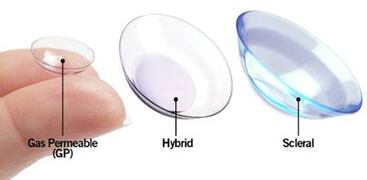SPECIALTY CONTACT LENSES
|
HISTORY
Leonardo da Vinci first conceived of the idea of a contact lens in 1508, but it wasn't until 1887 that someone actually produced one from blown glass and put it on a patient's eye. Contact lenses, as we now know them, first became popular in the 1950s as "hard lenses", which were made out of an extremely durable hard plastic. In fact, that same indestructible plastic was used for some popular screwdriver handles. It wasn't unusual for some patients to still be wearing those lenses twenty years after they were first dispensed! |
The first soft lenses came to market in 1971. They were designed to last about a year with daily cleaning and disinfection.
SOFT LENSES
It has been over 50 years since of the release of the first soft contact lens in 1971. Today's popular daily and monthly replacement soft lenses are the primary choice for contact lens vision correction offering excellent options for almost all types of vision problems including nearsightedness, farsightedness, astigmatism and the need for bifocals, typically needed for individuals over 42-years old as reading gets more difficult. Various soft lens materials address issues with corneal irregularities and corneal dryness. 50 years of continuous development has resulted in contact lenses that give super sharp vision for just about every vision condition and are barely noticeable, if at all, by the wearer. The Palmer Eyecare Center has thousands of demo lenses in stock to help you discover just how amazing the newest generation of soft contact lenses really is. We've been contact lens specialists since contact lenses were hard.
CUSTOM SPECIALTY CONTACT LENSES
There are, however, some vision conditions that require more precise correction to allow the eye to see clearly. For patients with medical corneal conditions and pathologies that interfere with the either the clarity of the cornea or the roundness and regularity of the of the cornea, specialty lenses may be utilized to address the cause of the decreased vision in order to correct it and regain clear, sharp vision. Essentially, the rigid contact lens creates a new optically perfect front surface of the eye.
It has been over 50 years since of the release of the first soft contact lens in 1971. Today's popular daily and monthly replacement soft lenses are the primary choice for contact lens vision correction offering excellent options for almost all types of vision problems including nearsightedness, farsightedness, astigmatism and the need for bifocals, typically needed for individuals over 42-years old as reading gets more difficult. Various soft lens materials address issues with corneal irregularities and corneal dryness. 50 years of continuous development has resulted in contact lenses that give super sharp vision for just about every vision condition and are barely noticeable, if at all, by the wearer. The Palmer Eyecare Center has thousands of demo lenses in stock to help you discover just how amazing the newest generation of soft contact lenses really is. We've been contact lens specialists since contact lenses were hard.
CUSTOM SPECIALTY CONTACT LENSES
There are, however, some vision conditions that require more precise correction to allow the eye to see clearly. For patients with medical corneal conditions and pathologies that interfere with the either the clarity of the cornea or the roundness and regularity of the of the cornea, specialty lenses may be utilized to address the cause of the decreased vision in order to correct it and regain clear, sharp vision. Essentially, the rigid contact lens creates a new optically perfect front surface of the eye.
|
The "rigid lens" materials currently used are actually highly engineered, wettable polymers that allow oxygen to pass through the lens while it is being worn to keep the cornea healthy.
Some of the custom lenses are hard; some are soft. Some are a hybrid of hard and soft. Some are small while some are as large as the entire cornea. The doctor determines what type and design is best to correct the patient's specific underlying condition. |
Learn about the benefits of gas permeable contact lenses at www.ContactLenses.org .

